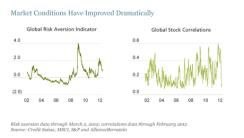In my blog post last month, I pointed to early signs of improving conditions for equity investors. Since then, several key indicators have bolstered my confidence in the outlook.
The unholy trinity of turbulence — volatility, risk aversion and correlation — looks like it’s starting to ease significantly. Of course, markets are still nervous and there are risks on the horizon, but I’m encouraged to see three gauges of market stress coming down after four tough years.
First, volatility: The Chicago Board Options Exchange’s Volatility Index (VIX) dropped 33 percent from the end of 2011, to 15.64 as of March 12. That’s 25 percent lower than its four-year average.
Second, our own Global Risk Aversion Indicator has come down from stubbornly high levels, as the display below shows. This index combines the implied volatility of equities, currencies, commodities and bonds with credit spreads and mutual fund flows, and can be a good harbinger of changes in risk appetite. Even after dropping 44 percent in the first two months of the year, it remains well above its long-term average. I think it still has a long way to go.

Last but not least, the pairwise correlation of individual stocks has taken a dive since the beginning of the year, as the display also shows. That is, stocks no longer tend to trade overwhelmingly in the same direction.
Declining correlations within the equities market are especially important for active managers. Since the global financial crisis began in late 2008, correlations have been extraordinarily high as investors, gripped with fear, have paid little attention to stock-specific attributes. As I’ve explained in previous posts, declining correlations suggest that investors are beginning to discriminate between stocks. We believe that this is a key ingredient to the success of research-driven investment strategies. Taken together, the recent trends of these three indicators suggest that market conditions for stock pickers are more promising than they’ve been for a long time.
What’s behind this shift? The biggest fundamental change in recent months is the European Central Bank’s resolute actions to support the euro area’s banking system with €1.1 trillion in loans since December. These moves have been crucial to convincing investors that the worst-case scenario of a systemic financial failure is not in the cards. Improving data on jobs and consumer spending in the US have also boosted investor confidence.
Of course, there are risks to the current equity rally. Perhaps the most potent threat comes from the Middle East, where the possibility of war between Israel and Iran is already putting pressure on oil prices. In my next post, I’ll present some research that we’ve been doing on the potential impact of a spike in oil prices on equity markets.
The views expressed herein do not constitute research, investment advice or trade recommendations and do not necessarily represent the views of all AllianceBernstein portfolio-management teams.
MSCI makes no express or implied warranties or representations, and shall have no liability whatsoever with respect to any MSCI data contained herein. The MSCI data may not be further redistributed or used as a basis for other indices, any securities or financial products. This report is not approved, reviewed or produced by MSCI.
Kevin Simms is Chief Investment Officer—International Value Equities at AllianceBernstein.






